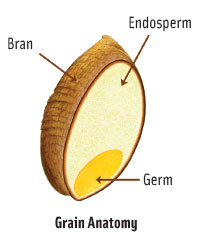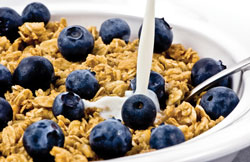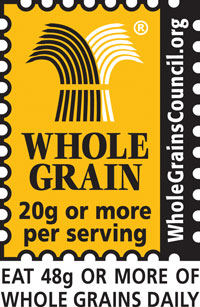Delivering Healthy and Affordable Whole Grain Foods
How can the food industry produce whole grain products that consumers will eat?

Health professionals recommend increasing consumption of whole grains, but obstacles prevent consumers from eating the recommended daily allowance of whole grains. Last year, more than 300 food and health experts from around the globe convened in Minneapolis, Minn., for the 2012 Whole Grains Summit. Here is a look at some of the challenges and opportunities identified during the conference.
A definition for what constitutes a whole grain was first developed in 1999 by the American Association of Cereal Chemists International and subsequently adapted by the U.S. Food and Drug Administration (FDA): “intact, ground, cracked, or flaked fruit of the grain whose principal components, the starchy endosperm, germ and bran, are present in the same relative proportions as they exist in the intact grain” (AACCI, 1999; FDA, 1999). The European HEALTHGRAIN Forum defines whole grains as consisting of the intact, ground, cracked, or flaked kernel after the removal of inedible parts such as the hull and husk. The principal anatomical components—the starchy endosperm, germ, and bran—are present in the same relative proportions as they exist in the intact kernel (Bjorck et al., 2012). Whole grains are barley, bulgur, corn (including popcorn), rice, rye, oats, millet, sorghum, teff, triticale, wheat, and wild rice as well as the so-called pseudo grains amaranth, buckwheat, and quinoa. Establishing a universally accepted definition is a priority as it would provide clarity for food manufacturers, aid in health promotion efforts, and protect consumers from false and misleading claims.
Despite recent efforts by the U.S. Dept. of Agriculture (USDA) to encourage Americans to consume half of the recommended six servings of grain-based foods a day as whole grains (48 g per day), most recently through the 2010 Dietary Guidelines for Americans and MyPlate, the median intake of U.S. adults is about one-half serving or 8 g per day. Less than 1% of the U.S. population consumes the recommended intake of three servings (48 g) a day, and 20% of individuals report consuming no whole grain products (USDA, 2010). By comparison, Sweden’s adult population consumes an average of 42 g per day of whole grains, the Danes consume 36 g, and Britons consume 14–16 g (Thane et al., 2007; Kyrø et al., 2011; Kyro et al., 2012). Greater incorporation of whole grain foods into the diet can improve overall diet quality. However, gaps exist between recommendations and intakes in several countries for both children and adults. Meeting recommendations to increase whole grain consumption would require the food industry to grow, manufacture, and sell more whole grain foods that promote health and contribute to appropriate energy balance.
Findings from observational studies suggest that consumption of two to three servings of whole grains a day is sufficient to demonstrate beneficial health effects such as reduced risk of cardiovascular disease, type 2 diabetes, and obesity. The 2010 U.S. Dietary Guidelines Advisory Committee reviewed the available evidence and concluded that there was moderate evidence that whole grain consumption is associated with a reduced risk of cardiovascular disease and lower body weight and limited evidence that it is associated with a reduced risk of type 2 diabetes. The development of a strategic research agenda is an important step in bringing together global research efforts, both epidemiological and intervention, to close existing knowledge gaps regarding whole grains and health. Establishing an internationally accepted definition for whole grains, whole grain foods, and a comprehensive whole-grain-food nutrient database would make comparative evaluations of studies from around the world feasible. Studies will also need to be conducted to elucidate the possible synergistic effects of the individual whole grain components.
 Barriers to Whole Grain Consumption
Barriers to Whole Grain Consumption
Among the barriers to increased consumption of whole grain foods are consumer taste preferences, the inability to identify whole grain foods, difficulty in the substitution of whole grains for existing ingredients in meal patterns, price, availability, and convenience (Kuznesof et al., 2012). Having the right resources and skills to identify, purchase, serve, and promote whole grain foods also appears to be a barrier (Hesse et al., 2009). Other environmental factors impacting availability of whole grain foods are staff, time, and labor needed for preparation of whole grain foods; location and size of the food service entity (school cafeteria, restaurants, etc.); and distance from distribution hubs. Repeat exposure, family-oriented activities like interactive newsletters and grocery tours, familiar looking foods that contain whole grains, and early introduction can gradually help consumers become more accustomed to whole grain foods, increase whole grain consumption, and improve the ability to identify whole grain foods (Ellis et al., 2005; Lafferty et al, 2006; Burgess-Champoux et al., 2008).
A stealth approach to substituting more healthful ingredients for less healthful options has been advocated. Consumer education efforts need to place greater emphasis on the substitution of whole grains for refined grains rather than simply adding more whole grains, and therefore more calories, to the diet. Finding different approaches to delivering practical, healthy, affordable, desirable whole grain foods will help make it easier for consumers to increase their whole grain intake.
Identification of a whole grain food is difficult because a universal definition for a whole grain food does not exist, and as a result, labeling of whole grain foods is inconsistent. In the United States, the message consumers generally receive is to purchase products that are 100% whole grain, display the whole grain stamp or the whole grain health claim, or have whole grains listed as the first ingredient on the label. The whole grain stamp program, developed by the Whole Grains Council, enables consumers to easily identify whole grain products that contain either 8 g or 16 g of whole grains per serving by the presence of a unique stamp on product labels. Adults have been found to generalize whole grains as wheat or having more fiber (Burgess-Champoux et al., 2006). If adults cannot identify whole grain foods, then consumption at different eating occasions will be limited. Finding effective ways to help consumers identify whole grain foods will be critical in promoting public health and advancing dietary recommendations. At the 2012 Whole Grains Summit, food and health professionals endorsed the need to standardize serving sizes in the United States and around the world as well as definitions for what constitutes a whole grain food.
--- PAGE BREAK ---
A barrier to meeting the whole grain recommendations of the dietary guidelines is the availability of whole grain foods. Hendrickson and others (2006) observed that foods available in both urban and rural food deserts were of inferior quality to foods found in non-food deserts; likewise, grocery stores tend to have more healthy foods than convenience stores (Glanz et al., 2007). Jetter and Cassady found that availability was impacted by the time period of the month with less availability at the end of the month (2006). It is likely that the recent changes in the U.S. Supplemental Nutrition Assistance Program’s food packages may impact the availability of nutritious food options in small grocery stores and corner stores.

Cost of whole grain foods may be higher than their refined grain counterparts, which could be a barrier that influences their availability in stores and whether consumers purchase them. For example, whole wheat bread in the United States costs on average $0.40 more than a loaf of refined bread, and similar price gaps exist for other whole grain products, with approximately a 25% increase in cost over their refined grain counterparts (Jetter and Cassady, 2006). Economic incentives to incorporate whole grain foods may be required to encourage availability of more whole grain foods.
Preparation time is another barrier that has been attributed to consumer adaptation of whole grain foods. Over the decades, meal preparation time has decreased by about 25% for both working and non-working women (Rose, 2007). Some whole grain products may take considerably more time to prepare than their refined grain counterparts. Furthermore, overcooking and holding of some whole grain foods can lead to undesirable changes in texture, reducing consumer appeal.
A recent trend of avoidance of all grain-based products is another obstacle to increasing consumption of whole grain foods. This is a growing global phenomenon because of real or perceived gluten intolerance or celiac disease, an inflammatory state of the small intestine that occurs in genetically predisposed individuals. Projections are that U.S. sales of gluten-free foods and beverages will exceed $5 billion by 2015 (Packaged Facts, 2011). Whatever the root cause of the increase, reduced intake of whole grain wheat products could result in decreased intake of whole grain foods and the accompanying fiber, micronutrients, and phytonutrients.
Another primary message of the 2010 Dietary Guidelines for Americans is to reduce sodium intake. Most of the sodium in the American diet comes from baked goods as well as fiber, which the dietary guidelines identified as a short-fall nutrient. This presents a nutrition/taste conundrum: how to increase whole grain and fiber consumption yet retain the familiar taste consumers enjoy without simultaneously increasing sodium intake above recommended limits. To address this issue, new technologies are being developed to reduce sodium content without affecting flavor, product safety, or shelf life. One such technology employs “inhomogeneous spatial distribution” of salt in the food matrix, which can achieve up to a 25% reduction in salt in bread without loss of flavor intensity and without addition of taste enhancers, aromas, or salt replacers (Noort et al., 2011).
Technological Challenges
While studies investigating the association between consumption of whole grains and health outcomes are essential, research into the development of improved technologies for processing whole grains to create more palatable whole grain food products that consumers will eat is equally important. Food technology innovations can influence consumer food choices, their nutrient intakes, and overall health. For example, breeding practices to increase fiber, micronutrients, and phytonutrients of grains can help improve overall nutrient profiles of grains and grain-based products but can impact the sensory attributes of the products. Whole grains have distinct sensory qualities that can contribute to their overall low consumption.
There is a growing need to make food convenient for consumers to follow dietary recommendations, giving rise to more quick-prepared and convenient seamless meals, like frozen and ready-to-eat (Rowe et al., 2011). While developing whole grain foods that are convenient, attention needs to be paid to the overall nutritional profiles of the products, especially added sugar, sodium, and fat, which may increase palatability and extend shelf life but negatively impact the nutritional profiles of products. Initiatives such as nutrition standards for school meals, food labeling, and limits on advertising have led manufacturers to continue to improve the nutritional profiles of whole grain foods. However, barriers exist that the food industry must overcome before it can reach its full potential and facilitate the mandate of the 2010 U.S. Dietary Guidelines for Americans and other global public health recommendations for consumption of whole grains.
The formulation and processing of foods made with whole grains differ from and can be more challenging to manufacture than those made with refined grains. Consumers tend to dislike the increased bitter taste and the coarse texture associated with certain grain components such as bran. Hence, it is prudent to develop technologies to help overcome these sensory barriers and negative perceptions of whole grain foods. To increase consumer acceptance of whole grains, it is important to optimize the flavor, color, and texture of foods made with whole grain ingredients. Health aspects of a food have a lower priority in the consumer’s mind than taste, convenience, or price (Rowe et al., 2011). All of these are important attributes that need to be taken into consideration when developing whole grain foods that are practical, affordable, healthy, and delicious.
The availability of whole grain foods in the retail marketplace hinges on consumer demand along with cost and industry’s ability to produce whole grain products and maintain an adequate return on investment. Whole grain products in the marketplace have grown significantly, from approximately 360 new product introductions in 2005 to more than 900 new product introductions in 2012 (Mintel International, 2012). Whole grain product innovations in the marketplace have included ready-to-eat cereals, pancakes, French toast, breads, pasta, crackers, snacks, wraps, entrees, and pizza crusts. Wheat flour tortilla is the fastest growing product line of all grain-based products, potentially indicative of a growing interest in whole grains and/or fiber intake for health (Rowe et al., 2011). Product reformulations and innovations that use the stealth approach may be the first step to enable the public to increase their whole grain consumption and meet dietary guidelines.
The 2010 U.S. dietary guidelines highlight specific grain foods, namely grain-based desserts, yeast breads, and pizza, as significant sources of calories, saturated fat, added sugars, and/or sodium. Replacing refined flour with whole grain flour and reducing sodium, fat, and added sugars can help create and sustain grain foods that better support dietary guidelines. Keast and others showed that replacing 25% of refined flour with whole grain wheat flour in foods such as breads/rolls, pizza crust, breakfast cereals, rice/pasta, quick breads such as tortillas, muffins, and waffles contributed to an increased intake of whole grains by 1.7 oz per day (2011). This substitution of whole grain for refined grain ingredients in commonly consumed foods can help increase the whole grain intake of the population.
--- PAGE BREAK ---
Taste is a critical aspect influencing consumer acceptance of whole grain products. A negative bitter flavor profile is associated with whole grain foods, potentially due to the phenolic compounds present in whole grains. Novel food technology solutions are needed to help mask undesired flavors and sensory perceptions while maintaining healthy nutritional profiles of whole grain products (Ferruzzi et al., 2012). For example, using white whole-wheat flour instead of traditional red whole-wheat flour in grain-based foods can help minimize changes in appearance, flavor, and texture and increase acceptance (Lukow et al., 2004). Ingredient specifications can also help catalyze introductions of nutrient rich, less calorie-dense whole grain-based foods that are widely accepted. For example, changes in U.S. School Nutrition Guidelines reflect an evolution of ingredient specification that facilitates using more whole grain-based foods in breakfasts and lunches.
While the technology to create whole grain foods exists, the higher costs of whole grains and the challenges presented in developing products acceptable to the broad range of consumer tastes have constrained the food industry and slowed progress toward creating a broader range of whole grain foods. Production processes and equipment would need to be tailored to increase production of whole grain products, but it is difficult to make significant, large-scale changes in processing facilities because of costs. In addition, challenges exist regarding the amount of whole grains that realistically can be incorporated into a food. For example, it is much easier to incorporate 8 g (1/2 serving) of whole grains into a cracker when the serving size is 30 g than when the serving size is only 15 g.
Communication and Collaboration
Crop breeders must also join in the discussion of whole grains and health. Modern wheat cultivars have been bred for high white flour yield, disease resistance, and food quality attributes unrelated to health. Wheat is considered a commodity, which keeps costs down, but it also holds back development of more nutritious ingredients. If the food industry were to shift its focus to wheat as an ingredient rather than a commodity, it would be more inclined to generate new varieties with improved nutritional profiles. This is evident from the Australian program, which has led to the introduction of a novel barley high in total dietary fiber and resistant starch. Also, a high resistant starch wheat is under development. However, such changes are complex and expensive—new product innovations can take several months to several years to develop—and do not come with guarantees that they will appeal to consumers (IOM, 2011).
It is imperative that lines of communication be established from consumer to processor and from processor to breeder. The goal is to facilitate the targeted breeding of grains such as wheat for improved health. This can be accomplished by integrating screening for bioactives into the selection protocol; evaluating the effects of bioactive compounds on mammalian metabolism through cell culture, animal, and clinical trials; and linking the effects to specific regions on the grain genome that can be targeted by plant breeders. This type of communication is taking place within the global oat-breeding program, where breeders are developing high-fiber, high-beta-glucan, and low-fat varieties. It will transform the future of oats by providing the ability to make biomarker-assisted selections, crop options, greater oat availability, and continued access to safe, heart-healthy whole grain food products (NAMA, 2009). The oat-breeding program could serve as a template for developing new cultivars of wheat and other whole grains with combined health, agronomic, and technological benefits. Enhanced communication must also take place among manufacturers, distributors, and key players in government, industry, and foodservice establishments. These discussions must consider rising energy and food-related costs, global chronic disease epidemics, and escalating healthcare costs.
In developing whole grain foods, cost considerations cannot be ignored, but the whole grain products benefit no one if consumers don’t like the taste. If the taste issue were resolved and consumer demand for whole grains increased, breeders, growers, and processors would have to ensure that supply keeps up with demand. A shift in the food supply would be essential to meet an increase in consumer demand for whole grain foods. A unified commitment by all sectors of the supply chain is needed to create a sustainable food environment that ensures which new grain-based foods will also meet consumers’ demands for convenience and good taste. The inclusion of more whole grains should also emphasize a more healthful overall food and nutrient profile. For this to take place, it will be necessary to build multi-sector partnerships across the food supply chain and embrace shared value (i.e., developing and delivering better-for-you grain-based foods to consumers that will contribute to the good of business and to the well-being of society). This would allow the industry to rise to the challenge put forth by the 2010 Dietary Guidelines Advisory Committee to make the healthy choice the easy choice and set the stage for increased consumption of whole grains to be an integral component of future dietary recommendations.
Accommodating an increased demand for whole grain foods will take time to accomplish, and the industry must work together to make incremental changes throughout the supply chain to create more healthful food products and make them available to consumers. A 10- to 15-year time frame would permit all sectors involved to adapt to the changes. This is a unique opportunity for the grain industry to set an example for how to effectively and efficiently translate nutrition policy into healthy products on grocery shelves. A well-planned strategic agenda will ultimately have far reaching effects on global health.
Disclosure: S.S. Jonnalagadda is an employee of General Mills Inc.; B. Jan-Willem van Klinken is an employee of PepsiCo Inc.; G. Jensen is an employee of Roman Meal Company; E. Arndt is an employee of ConAgra Foods. The views expressed in this article are those of the authors and do not necessarily reflect the position or policy of General Mills, Inc., PepsiCo, Inc., Roman Meal Company, and ConAgra Foods.
Multimedia Highlights of the 2012 Whole Grains Summit
Held May 19–22, 2012, in Minneapolis, Minn., the 2012 Whole Grains Summit was a convergence of professionals in science, business, and health to review and analyze research on whole grains and dietary fiber. Speakers examined ways to increase the amount of whole grains in food products and the availability of healthy grain-based foods, thereby increasing consumer intake of healthy whole grains. Topics addressed during the summit included research evidence of the health benefits of whole grains, challenges to meeting dietary guidelines of wholegrain intake, the benefits and nuances of nutrients in whole grains, the nutritional futility of refined grains, and much more.
Presenters at the summit were U.S. Senator Amy Klobuchar (D-Minn.), who discussed the importance of whole grains in relation to public health; Robert Post of the U.S. Dept. of Agriculture, who discussed the role of whole grains in the diet; Roger Clemens of the Univ. of Southern California, who discussed whole grains in relation to food science; Kathy Wiemer of General Mills, who discussed global perspectives of whole grains; and Chris Seal of Newcastle University, who discussed the inconsistencies in whole-grain epidemiological research. George Mensah of PepsiCo, Sylvia Rowe of SR Strategy, Marc Manley of Blue Cross and Blue Shield, and other notable experts also gave presentations.
Videos of presentations at the summit are available at the following webpage: www.bellinstitute.com/2012_Whole_Grains_Summit.aspx. To watch interviews with whole-grain experts, visit www.bellinstitute.com/Whole_Grain_Expert_Video_Interviews.aspx.
Leonard F. Marquart, Ph.D., R.D., a member of IFT, is Associate Professor, Dept. of Food Science & Nutrition, Univ. of Minnesota, 267 FScN, 1334 Eckles Ave., St. Paul, Minn. 55108 ([email protected].). Satya S. Jonnalagadda, Ph.D., is Principal Scientist at General Mills Bell Institute of Health & Nutrition, 9000 Plymouth Avenue N, Golden Valley, Minn. 55427 ([email protected]). B. Jan-Willem van Klinken, M.D., Ph.D., is Director of Nutrition, PepsiCo Research & Development, 617 W. Main St., Barrington, Ill. 60010 ([email protected]). Roger Clemens, Dr.P.H., a Professional Member of IFT, is Professor, Univ. of Southern California, 1540 Alcazar St., Los Angeles, Calif. 90089 ([email protected]). Gary Jensen is President, Roman Meal Company, 2101 S. Tacoma Way, Tacoma, Wash. 98409 ([email protected]). Elizabeth Arndt, Ph.D., a member of IFT, is Director, Research & Development, ConAgra Foods, 6 Con Agra Drive, Omaha, Neb. 68102 ([email protected]). Densie Webb, Ph.D., R.D., is Science Writer, Nutrition and Health Communications, 8014 Greenslope Drive, Austin, Tex. 78759.
References
AACCI (American Association of Cereal Chemists Int’l). 1999. Whole-grain definition. http://www.aaccnet.org/initiatives/definitions/Pages/WholeGrain.aspx. Accessed June 1, 2012.
Burgess-Champoux, T., Marquart, L., Vickers, Z., and Reicks, M. 2006. Perceptions of children, parents, and teachers regarding whole-grain foods, and implications for a school-based intervention. J. Nutr. Educ. Behav. 38: 230–237.
Burgess-Champoux ,T.L., Chan, H.W., Rosen, R., Marquart, L., and Reicks, M. 2008. Healthy whole-grain choices for children and parents: a multi-component school-based pilot intervention. Public Health Nutr. 11: 849–859.
Ellis, J., Johnson, M.A., Fischer, J.G., and Hargrove, J.L. 2005. Nutrition and health education intervention for whole grain foods in the Georgia older Americans nutrition programs. J. Nutr. Elder. 24: 67–83.
Ferruzzi, M.G., Peterson, D.G., Singh, R.P., Schwartz, S.J., and Freedman, M.R. 2012. Nutritional translation blended with food science: 21st century applications. Adv. Nutr. 1;3(6): 813–819.
FDA (U.S. Food and Drug Administration). 1999. Health claim notification for whole-grain foods. www.fda.gov/Food/LabelingNutrition/LabelClaims/ FDAModernizationActFDAMAClaims/ucm073639. Accessed June 1, 2012.
Glanz, K., Sallis, J.F., Saelens, B.E., and Frank, L.D. 2007. Nutrition environment measures survey in stores (NEMS-S): development and evaluation. Am. J. Prev. Med. 32: 282–289.
Hendrickson, D., Smith, C., and Eikenberry, N. 2006. Fruit and vegetable access in four low-income food deserts communities in Minnesota. Agric. Human Values 23: 371–383.
Hesse, D., Braun, C., Dostal, A., Jeffery, R., and Marquart, L. 2009. Barriers and opportunities related to whole grain foods in Minnesota school foodservice. J. Child Nutr. Manag. 33(1).
IOM (Institute of Medicine). 2011. Leveraging food technology for obesity prevention and reduction efforts – workshop summary. National Academies Press (U.S.), Washington, D.C.
Jetter, K.M. and Cassady, D.L. 2006. The availability and cost of healthier food alternatives. Am. J. Prev. Med. 30: 38–44.
Keast, D.R., Rosen, R.A., Arndt, E.A., and Marquart, L.F. 2011. Dietary modeling shows that substitution of whole-grain for refined-grain ingredients of foods commonly consumed by U.S. children and teens can increase intake of whole grains. J. Am. Diet. Assoc. 111: 1322–1328.
Kuznesof, S., Brownlee, I.A, Moore, C., et al. 2012. WHOLEheart study participant acceptance of wholegrain foods. Appetite 59: 187–193.
Kyrø, C., Skeie, G., Dragsted, L.O., et al. 2011. Intake of whole grains in Scandinavia is associated with healthy lifestyle, socio-economic and dietary factors. Public Health Nutr. 14: 1787–1795.
Kyrø, C., Skeie, G., Dragsted, L.O., et al. 2012. Intake of whole grain in Scandinavia: intake, sources and compliance with new national recommendations. Scand. J. Public Health 40: 76–84.
Lafferty, A., Marquart, L., and Reicks, M. 2006. Hunting for whole grains: a supermarket tour. J. Nutr. Educ. Behav. 38: 197–198.
Lukow, O.M., Guinard, J.X., and Adams, K.M. 2004. Whole wheat bread preference of children. Presented at the American Association of Cereal Chemists Int’l Annual Meeting, San Diego, Calif.
Mintel International. 2012. Global new products database. A host of whole grain products driving sector’s growth. http://www.mintel.com/. Accessed October 10, 2012.
NAMA (North American Millers Association). 2009. NAMA millers fund global oat research project to preserve the future of U.S. oats and promote innovation http://www.namamillers.org/nama-millers-fund-global-oat-research-project-to-preserve-the-future-of-u-s-oats-and-promote-innovation/ Accessed October 25, 2012.
Noort, M.W.J., Bult, J.H.F., Stieer, M., and Hamer, R.J. 2011. Saltiness enhancement in bread by inhomogeneous spatial distribution of sodium chloride. J. Cereal Chem. 141: 2249–2255.
Packaged Facts. 2011. Gluten-free foods and beverages in the U.S., 3rd ed. Rockville, Md.
Rose, D. 2007. Food stamps, the thrifty food plan, and meal preparation: rhe importance of the time dimension for U.S. nutrition policy. J. Nutr. Educ. Behav. 39: 226–232.
Rowe, S., Alexander, N., Almeida, N., Black, R., et al. 2011. Food science challenge: translating the dietary guidelines for Americans to bring about real behavior change. J. Food Sci. 76: R29–R37.
Thane, C.W., Jones, A.R., Stephen, A.M., Seal, C.J., and Jebb, S.A. 2007. Comparative whole-grain intake of British adults in 1986-7 and 2000-1. Br. J. Nutr. 97: 987–992.
USDA (U.S. Dept. of Agriculture). 2010. Report of the dietary guidelines advisory committee on the dietary guidelines for Americans, 2010. http://www.cnpp.usda.gov/dgas2010-dgacreport.htm. Accessed May 30, 2013.
